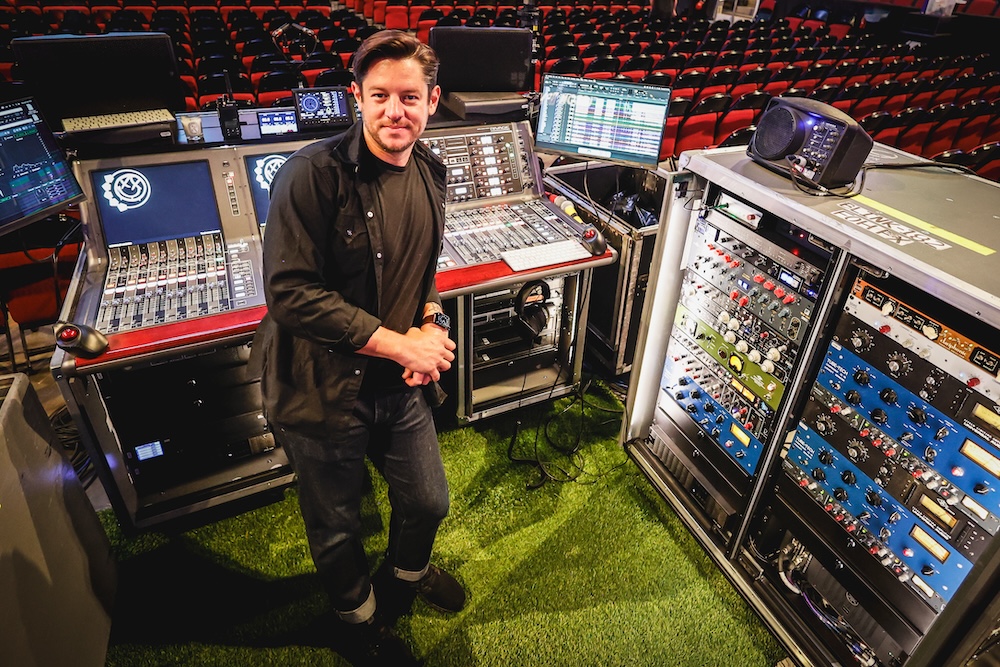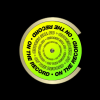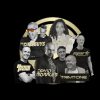-
 play_arrow
play_arrow
Clubalicious Clubalicious Radio
-
 play_arrow
play_arrow
London Calling Podcast Yana Bolder

Despite first gatecrashing the scene nearly three decades ago, 2023 was arguably one of the biggest years ever for Blink-182. The band’s classic lineup of Tom DeLonge, Mark Hoppus and Travis Barker reunited for the first time since 2014 for a 60-plus date world tour, and capped it off with a new album in October, the aptly titled One More Time…. Of course, with a name like that, it was inevitable they’d return to the road for another go-round, so the pop-punk pioneers are currently lighting up stadiums, arenas and a handful of sheds across North America.
Along for the ride through it all are engineers Charles Izzo and Ray Jeffrey at the front-ofhouse and monitor mix positions, respectively, overseeing audio systems provided by Clair Global. With most of the current North American leg performed in-the-round, the pair have their work cut out for them, bringing the band’s exuberant, clean punk sound to every seat in the house.

“For the most part, it is just a straightforward rock show,” said Izzo, who’s mixed the likes of Halsey, Childish Gambino and Portugal. The Man. “I try to stay as true to the albums as possible; I feel like they’re classic records that everybody knows, so any effect that happens on the record, I duplicate. As far as the live element goes, I keep it really aggressive with an in-yourface, ‘rock show on top of the record’ sound.”
Building that sound on a Yamaha Rivage PM10 console, Izzo has snapshots for every song, explaining, “There are changes that need to happen, but a lot of the root, foundational stuff—drums, guitars, bass—stays pretty static. It’s the other elements that come and go that make it more dynamic. For instance, a lot of the newer songs have more going on than the older records do—synth sounds, cool percussion elements and things of that nature—so putting all that together keeps it interesting to mix.”
Izzo opted for the PM10 based on word of mouth and an array of options that match his mixing style, noting, “The fact that it has a lot of Rupert Neve Designs components, Bricasti reverbs and Eventides built into it was a big, big push for me to go that way. My analog rack is already a double-wide, and if I used a different desk, it would probably be a triple-wide. I feel that as P.A.s get better, the expectation—and the ability—to have better, studio-quality sound is changing as well; I think that’s why more engineers are leaning toward bringing studio gear out on tour now.”
You can count Izzo as one of those pros, too, because while he uses a smattering of SoundToys plug-ins hosted on a Waves SuperRack Performer rig, the FOH outboard racks are stuffed with high-end gear, much of it from Rupert Neve Designs. The mastering chain on the left-right bus is built around a Dramastic Audio Obsidian compressor leading into a Chandler Limited EMI TG12345 Curve Bender mastering EQ, followed by a RND Master Bus Converter. Also residing in the same rack are an Empirical Labs Distressor for bass with an Acme Audio Opticom compressor on the parallel bus, while the drum parallel bus gets an Empirical Fatso, and the guitar bus benefits from an API 2500+ bus compressor and RND Master Bus Transformer.

Also in the racks are identical vocal chain setups for Hoppus and DeLonge, each running from a Universal Audio 1176LN into a Tube-Tech CL 1B compressor, followed by RND 5045 Primary Source Enhancer and Shelford Channel units, before closing out with a Kush Audio Clariphonic parallel EQ used to bring out the vocals and make them more present in the mix.
Capturing those vocals onstage are DPA 4018VL handheld vocal mics on Shure Axient wireless. “I feel like DPA is such a pop-world thing,” said Jeffrey. “I’ve been working for Lorde for seven years, and that’s been DPA since Day One, so coming over to this tour, the first phone call with Charlie was like, ‘DPA?’ ‘Yeah.’ That was our first choice—and then the band had never used them! But Mark and Tom gave us their trust, let us run with it, and they’re very happy with them.”
The guitars run into a Fractal Audio AXE FX III while the bass hits a Neural DSP Quad Cortex, each continuing on to a Rupert Neve Designs 5211 mic preamp, so the only live mics onstage are the vocals and drums. With the exception of Josephson e22S condensers for snare bottoms, everything else is from DPA microphones, including a 4055 on the kick and 4099-Ds on the snare tops.
In a show full of highlights, one of the biggest is when Travis Barker’s drum kit takes to the air, flying and spinning around as he plays—a moment that is very cool but which also makes using overhead mics above the kit impossible. As a result, they use underheads instead, opting for 4015 wide cardioids to pick up the entire kit.
“They’re suspended out about 18 inches to two feet from the drum kit on arms from the crash and ride cymbals,” said Jeffrey. “Honestly, it was just trial and error moving them around to where we were getting every element of the kit, and they sound great.”
Because the drum kit takes to the air, getting signal from those mics to the rest of the system took some brainstorming, too. “The creative team was trying to figure it out, and I said, ‘Well, this could just be two ethernet cables,” said Jeffrey. “We have a little five-space rack with Rupert Neve RMP-D8 mic preamps, right on the riser with Travis, sitting in the back running Dante; Charlie controls the Dante, and they sound amazing.”

Over in monitorworld, Jeffrey mixes on a DiGiCo Quantum 5 console, and his supplementary outboard gear, much like FOH, is centered around RND 5045s and Shelford Channel units, Bricasti M7s, and a Waves SuperRack setup for a handful of plug-ins.
While the stage sports some “Texas Headphone”-style drum fills that are L-Acoustics KS21s with A15 tops, the band hears its mixes through Sensaphonics and JH Audio in-ear monitors via Wisycom wireless. “First and foremost with Wisycom is the sound quality,” said Jeffrey, “but then a big bonus is you can keep the same rack and travel the world. You can do a South America tour and then head to the U.K. and follow it up in L.A. With the RF environments now being kind of nasty, you need it.”
Noah Kahan: Singer, Songwriter, Stadium Filler
The result is a relatively quiet stage, a factor aided by the use of d&b audiotechnik P.A. at each stop, covering arenas with KSL boxes and stadiums with GSL systems bolstered by KSL-Subs. “They’re great, especially in the round where we’re putting out that much energy into every corner of the room,” said Izzo. “We tried placing the subs in the corners, which is more traditional for inthe- round, then Christian Peterson, my SE, had the brilliant idea of doing center-flown subs. We were very fortunate that we had time at Rock Lititz before the tour to hang the P.A. twice, so we tried both and found that center-flown subs are far more cohesive for what the band plays, and there’s way more control on the stage with them. None of it is blowing back on the stage for Ray, which is a big, big plus for him.”
Getting the P.A. tuned up requires an extensive virtual soundcheck…and perhaps a test of the crew’s patience: “I put on the song ‘I Miss You,’” said Izzo, “which everybody in the room is probably tired of at this point because I play it about 30 times while me and Christian walk around every seat to make sure everything sounds right.”
The crew can look forward to hearing that song plenty more times, too, as the North American leg may end this month, but the group will head back to the U.K. for more shows before wrapping up with a spate of U.S. festivals. When all is said and done in the fall, Blink-182 will have played more than 120 shows in 19 months.
Written by: Admin
Similar posts
Recent Comments
No comments to show.Featured post

Latest posts
Current show

On The Record
Insomniac Events
On The Record is a weekly radio show featuring an endless rotation of the most noteworthy artists from around the world.
closeUpcoming shows

Femme House
Lp giobbi
00:00 - 01:00
On The Record
Insomniac Events
01:00 - 02:00
Fresh Is Fresh
This Weeks Hottest Releases
02:00 - 09:00
Love To Be
The Global Connection
09:00 - 11:00
Fresh Is Fresh
This Weeks Hottest Releases
11:00 - 15:00Chart
Powered by Dee jay promotions visit us












 Invalid license, for more info click here
Invalid license, for more info click here